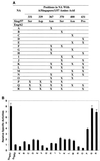Amino acids responsible for the absolute sialidase activity of the influenza A virus neuraminidase: relationship to growth in the duck intestine
- PMID: 11689658
- PMCID: PMC114763
- DOI: 10.1128/JVI.75.23.11773-11780.2001
Amino acids responsible for the absolute sialidase activity of the influenza A virus neuraminidase: relationship to growth in the duck intestine
Abstract
The 1957 human pandemic strain of influenza A virus contained an avian virus hemagglutinin (HA) and neuraminidase (NA), both of which acquired specificity for the human receptor, N-acetylneuraminic acid linked to galactose of cellular glycoconjugates via an alpha2-6 bond (NeuAcalpha2-6Gal). Although the NA retained considerable specificity for NeuAcalpha2-3Gal, its original substrate in ducks, it lost the ability to support viral growth in the duck intestine, suggesting a growth-restrictive change other than a shift in substrate specificity. To test this possibility, we generated a panel of reassortant viruses that expressed the NA genes of human H2N2 viruses isolated from 1957 to 1968 with all other genes from the avian virus A/duck/Hong Kong/278/78 (H9N2). Only the NA of A/Singapore/1/57 supported efficient viral growth in the intestines of orally inoculated ducks. The growth-supporting capacity of the NA correlated with a high level of enzymatic activity, comparable to that found to be associated with avian virus NAs. The specific activities of the A/Ann Arbor/6/60 and A/England/12/62 NAs, which showed greatly restricted abilities to support viral growth in ducks, were only 8 and 5%, respectively, of the NA specific activity for A/Singapore/1/57. Using chimeric constructs based on A/Singapore/1/57 and A/England/12/62 NAs, we localized the determinants of high specific NA activity to a region containing six amino acid substitutions in A/England/12/62: Ser331-->Arg, Asp339-->Asn, Asn367-->Ser, Ser370-->Leu, Asn400-->Ser, and Pro431-->Glu. Five of these six residues (excluding Asn400) were required and sufficient for the full specific activity of the A/Singapore/1/57 NA. Thus, in addition to a change in substrate specificity, a reduction in high specific activity may be required for the adaptation of avian virus NAs to growth in humans. This change is likely needed to maintain an optimal balance between NA activity and the lower affinity shown by human virus HAs for their cellular receptor.
Figures




References
-
- Baum L G, Paulson J C. The N2 neuraminidase of human influenza virus has acquired a substrate specificity complementary to the hemagglutinin receptor specificity. Virology. 1991;180:10–15. - PubMed
-
- Connor R J, Kawaoka Y, Webster R G, Paulson J C. Receptor specificity in human, avian, and equine H2 and H3 influenza virus isolates. Virology. 1994;205:17–23. - PubMed
-
- Couceiro J N, Paulson J C, Baum L G. Influenza virus strains selectively recognize sialyloligosaccharides on human respiratory epithelium: the role of the host cell in selection of hemagglutinin receptor specificity. Virus Res. 1993;29:155–165. - PubMed
-
- Hinshaw V S, Webster R G, Naeve C W, Murphy B R. Altered tissue tropism of human-avian reassortant influenza viruses. Virology. 1983;128:260–263. - PubMed
Publication types
MeSH terms
Substances
Grants and funding
LinkOut - more resources
Full Text Sources

